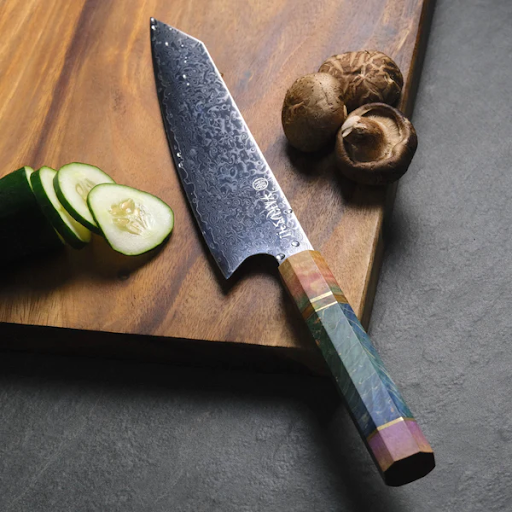In culinary craftsmanship, choosing kitchen tools can elevate a chef’s artistry to new heights. One such masterpiece that stands out in the world of cutlery is the Damascus Kiritsuke knife. With its exceptional blend of form and function, this knife embodies precision, versatility, and the timeless beauty of Damascus steel. In this exploration, we’ll delve into the rich history, unique features, and unparalleled artistry of the Damascus Kiritsuke knife that has earned it a revered place in the hands of culinary enthusiasts and professionals alike.
Historical Roots
The origins of the Damascus Kiritsuke knife can be traced back to Japan, where traditional craftsmanship and culinary excellence converge. The Kiritsuke knife is a hybrid, combining elements of two traditional Japanese knife styles: the Yanagiba and the Usuba. Historically, the Kiritsuke was considered a multi-purpose knife reserved for master chefs in Japanese kitchens.
The term “Damascus” refers to the distinctive blade patterns achieved through the art of layering and folding steel. This ancient technique originated in the Middle East and later found its way to Japan, where it became synonymous with producing high-quality, visually stunning blades.
Unique Features of the Damascus Kiritsuke Knife
Versatility
The Damascus Kiritsuke knife is celebrated for its versatility. It combines the slicing prowess of a Yanagiba with the chopping abilities of a Usuba, making it a true all-in-one tool for chefs who appreciate efficiency in the kitchen.
Distinctive Blade Profile
The blade of the Damascus Kiritsuke knife typically features a long, graceful curve with a pointed tip. This unique profile enables precise slicing and intricate vegetable work, showcasing the knife’s adaptability in a professional kitchen setting.
Exquisite Damascus Patterns
What truly sets the Damascus Kiritsuke apart is its breathtaking aesthetic. Crafted from Damascus steel, the blade exhibits mesmerizing wave-like patterns created through the layering and folding of multiple steel alloys. This enhances the knife’s visual appeal and contributes to its exceptional strength and durability.
Hardness and Edge Retention
Damascus steel, known for its superior hardness, allows the Kiritsuke knife to maintain a sharp edge for prolonged periods. This feature is particularly advantageous for chefs who demand
precision in their cuts and desire a knife that withstands the rigors of a busy kitchen.
Balanced Design
The Damascus Kiritsuke is designed with balance in mind. The harmonious weight distribution between the blade and handle gives chefs optimal control, reducing hand fatigue during extended use.
Culinary Applications
The Damascus Kiritsuke knife is prized for its ability to excel across a spectrum of culinary tasks:
Slicing and Dicing
The long, slender blade is ideal for precision slicing, making it perfect for delicate tasks such as slicing sashimi or preparing intricate garnishes.
Chopping and Rocking
The Kiritsuke’s broader blade facilitates efficient chopping and rocking motions, making it adept at handling a wide range of vegetables, meats, and herbs.
Presentation
With its stunning Damascus patterns and elegant profile, the Damascus Kiritsuke knife is often used for presentation. Chefs appreciate its ability to create visually appealing dishes with clean, precise cuts.
Caring for Your Damascus Kiritsuke Knife
Hand Washing
Hand wash the knife with mild soap and warm water to preserve the integrity of the Damascus steel and maintain its aesthetic appeal. Avoid abrasive scouring pads and dishwashers.
Sharpening and Honing
Regular sharpening and honing are essential to keep the damascus steel kitchen knives in peak condition. Professional sharpening services or honing with a quality sharpening stone can be employed.
Proper Storage
Store the knife in a knife block, magnetic strip, or blade guard to protect the blade from damage and ensure safety in the kitchen.
Oil the Blade
To prevent corrosion, lightly oil the blade with food-safe mineral oil or a similar product after each use.
Conclusion
The Damascus Kiritsuke knife is not merely a kitchen tool but a testament to the artistry and craftsmanship honed over centuries. Combining functionality, versatility, and aesthetic beauty, this knife has become a cherished companion for chefs who aspire to culinary greatness.
